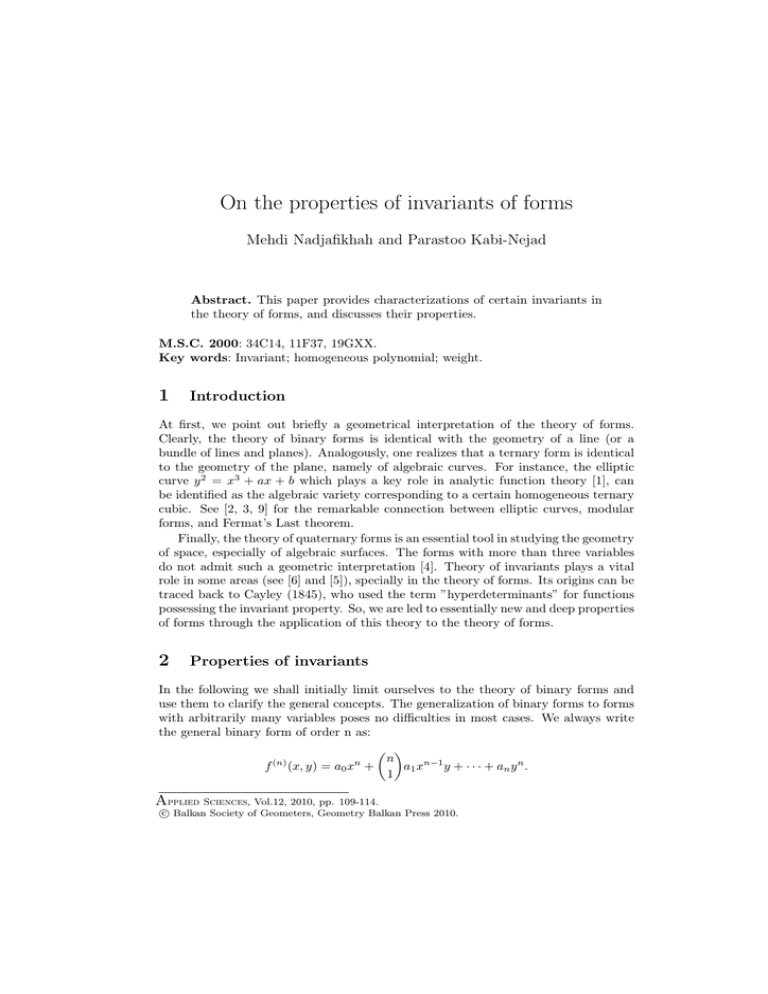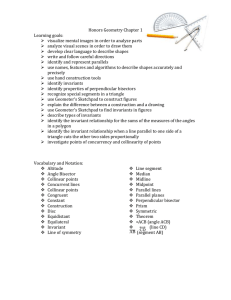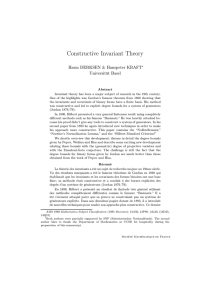On the properties of invariants of forms
advertisement

On the properties of invariants of forms
Mehdi Nadjafikhah and Parastoo Kabi-Nejad
Abstract. This paper provides characterizations of certain invariants in
the theory of forms, and discusses their properties.
M.S.C. 2000: 34C14, 11F37, 19GXX.
Key words: Invariant; homogeneous polynomial; weight.
1
Introduction
At first, we point out briefly a geometrical interpretation of the theory of forms.
Clearly, the theory of binary forms is identical with the geometry of a line (or a
bundle of lines and planes). Analogously, one realizes that a ternary form is identical
to the geometry of the plane, namely of algebraic curves. For instance, the elliptic
curve y 2 = x3 + ax + b which plays a key role in analytic function theory [1], can
be identified as the algebraic variety corresponding to a certain homogeneous ternary
cubic. See [2, 3, 9] for the remarkable connection between elliptic curves, modular
forms, and Fermat’s Last theorem.
Finally, the theory of quaternary forms is an essential tool in studying the geometry
of space, especially of algebraic surfaces. The forms with more than three variables
do not admit such a geometric interpretation [4]. Theory of invariants plays a vital
role in some areas (see [6] and [5]), specially in the theory of forms. Its origins can be
traced back to Cayley (1845), who used the term ”hyperdeterminants” for functions
possessing the invariant property. So, we are led to essentially new and deep properties
of forms through the application of this theory to the theory of forms.
2
Properties of invariants
In the following we shall initially limit ourselves to the theory of binary forms and
use them to clarify the general concepts. The generalization of binary forms to forms
with arbitrarily many variables poses no difficulties in most cases. We always write
the general binary form of order n as:
µ ¶
n
(n)
n
f (x, y) = a0 x +
a1 xn−1 y + · · · + an y n .
1
Applied Sciences, Vol.12, 2010, pp.
109-114.
c Balkan Society of Geometers, Geometry Balkan Press 2010.
°
110
Mehdi Nadjafikhah and Parastoo Kabi-Nejad
Example 2.1. Consider the homogeneous quadratic polynomial
(2.1)
Q(x, y) = ax2 + 2bxy + cy 2
in two variables x, y. Clearly we can recover the inhomogeneous quadratic polynomial
from the associated quadratic form and vice versa.
A glance observation shows that any invertible linear transformation
(2.2)
x = αx + βy,
y = γx + δy,
αδ − βγ 6= 0
will map a homogeneous polynomial in x and y to a homogeneous polynomial in x
and y according to
(2.3)
Q(x, y) = Q(αx + βy, γx + δy) = Q(x, y).
Remarkably, the discriminant of the transformed polynomial is directly related to
that of the original quadratic form. A straightforward computation shows that they
agree up to the square of the determinant of the coefficient matrix for the linear
transformation (2.2):
(2.4)
2
2
2
4 = ac − b2 = (αδ − βγ) (ac − b ) = (αδ − βγ) 4.
Therefore, by induction the defining equation of the invariants is
I(a00 , a01 , · · · , a0n ) = δ p I(a0 , a1 , · · · , an ).
Definition 2.2. The expressions g = ν0 + ν1 + · · · + νn and ν1 + 2ν2 + 3ν3 + · · · + nνn
are called the degree and the weight of a function
X
I(a0 , a1 , . . . , an ) =
Zν0 ν1 ···νn aν00 aν11 · · · aνnn ,
respectively, where Zν0 ν1 ···νn are numerical coefficients. See [4] for more details.
Note. In this paper, we shall assume that all terms of a function have the same
weight.
Lemma 2.3. Every linear transformation of binary forms can be composed of the
following three types of linear transformations:
(2.5)
(2.6)
x = αx0 ,
y = δy 0 ,
x = x0 + βy,
y = y0 ,
(2.7)
x = x0 ,
y = γx0 + y 0 .
Theorem 2.4. Every invariant of a form must be homogeneous in its coefficients and
every term must have degree g = 2p
n , where p is the exponent of the transformation
determinant by which the invariant changes under substitution of the transformed
coefficients. Furthermore, all terms must have the same weight, which is also equal
to p.
On the properties of invariants of forms
111
Proof. Since a general linear transformation is composed of these three types of
transformations, the application of a general transformation will not lead to any new
results. We apply the linear transformation
x = αx0 ,
y = δy 0
to the binary form
µ ¶
µ ¶
n
n
n−1
f (x, y) = a0 x +
a1 x
y + ··· +
ai xn−i y i + · · · + an y n .
1
i
n
The given form then becomes:
f
where
¡ ¢
n
n−1
= f (αx0 , δy 0 ) = a0 αn x0 + n1 a1 αn−1 x0
δy 0 + · · ·
¡ ¢
n−i i 0 i
n
+ · · · + ni ai αn−i x0
δ y + · · · an δ n y 0
¡ ¢
¡ ¢
n−i 0 i
n
n
n−1 0
y + · · · + a0n y 0 ,
= a00 x0 + n1 a01 x0
y + · · · + ni a0i x0
a00 = a0 αn , a01 = a1 αn−1 δ, . . . , a0i = ai αn−i δ i , . . . , a0n = an δ n .
Now, let
I(a0 , a1 , · · · , an ) =
X
Zν0 ν1 ···νn a0 ν0 a1 ν1 · · · an νn
be an invariant of the form f , where the Z are numerical coefficients. Then we have
the identity
I(a00 , a01 , · · · , a0n ) =
=
I(a0 αn , a1 αn−1 δ, · · · , an δ n )
X
{Zν0 ν1 ···νn a0 ν0 αnν0 a1 ν1 α(n−1)ν1 δ ν1
=
· · · ai νi α(n−i)νi δ iνi · · · an νn δ nνn }
X
{Zν0 ν1 · · · νn a0 ν0 a1 ν1 · · · ai νi · · · an νn
=
.αnν0 +(n−1)ν1 +···+(n−i)νi +···+νn−1 δ ν1 +···+iνi +nνn }
X
Zν0 ν1 ···νn a0 ν0 a1 ν1 · · · an νn ,
αp δ p
from which we obtain the identities
nν0 + (n − 1)ν1 + · · · + (n − i)νi + · · · + νn−1 = p,
ν1 + · · · + iνi + · · · + (n − 1)νn−1 + nνn = p.
Additionally to these formulas we infer: n(ν0 + ν1 + · · · + νn ) = 2p.
So, the two characteristic equations we have found are the following
ν1 + 2ν2 + 3ν3 + · · · + nνn = p,
¤
ng = 2p.
On the other hand, the theorem just proven has evidently a converse.
Theorem 2.5. Every homogeneous function of the coefficients a, which satisfies the
equation ng − 2p = 0, where g is the degree, p the weight of this function, and n the
order of the base form, is an invariant with respect to transformation (2.5).
The proof is evident; if one substitutes the a0 instead of the a into I, then a factor
αp δ p appears because of the assumed identities. So, we avoid repeating it.
112
3
Mehdi Nadjafikhah and Parastoo Kabi-Nejad
The operation symbols D and ∆
We introduce two special operational symbols
D
∂
∂
∂
∂
+ 2a1
+ 3a2
+ · · · + nan−1
,
∂a1
∂a2
∂a3
∂an
∂
∂
∂
∂
na1
+ (n − 1)a2
+ (n − 2)a3
+ · · · + an
.
∂a0
∂a1
∂a2
∂an−1
= a0
∆ =
that are two infinitesimal generators of the unimodular group.
Lemma 3.1. The operations D and ∆ applied to a homogeneous function, leave the
degree g in the ai unchanged; D lowers the weight p by 1, that is, to p − 1; ∆ raises
it by 1, to p + 1. Also, homogeneity is preserved by these operations.
Theorem 3.2. If A is a homogeneous function in the ai , of degree g and weight p,
then
(3.1)
(D∆ − ∆D)A = (ng − 2p)A.
Proof. We prove this theorem in three steps:
1. If formula (3.1) is valid for two expressions A1 and A2 which have the same degree
g and the same weight p, then it is also valid for the sum A1 + A2 . From
(D∆ − ∆D)A1
(D∆ − ∆D)A2
=
=
(ng − 2p)A1 ,
(ng − 2p)A2 ,
it follows immediately by addition that
(D∆ − ∆D)(A1 + A2 ) = (ng − 2p)(A1 + A2 ).
2. If the formula is valid for A1 (degree= g1 , weight= p1 ) and A2 (degree= g2 , weight=
p2 ), then it is also valid for the product A1 A2 . The product is easily seen to be a
homogeneous function of degree g = g1 + g2 and weight p = p1 + p2 . According to
our assumptions, we have now
(D∆ − ∆D)A1 = (ng1 − 2p1 )A1 ,
(D∆ − ∆D)A2 = (ng2 − 2p2 )A2 .
Using the rules, one finds for the product:
(D∆ − ∆D)(A1 A2 ) = D∆(A1 A2 ) − ∆D(A1 A2 )
=
=
D{A1 ∆A2 + A2 ∆A1 } − ∆{A1 DA2 + A2 DA1 }
A1 D∆A2 + {∆A2 }{DA1 } + A2 D∆A1 + {∆A1 }{DA2 }
=
−A1 ∆DA2 − {DA2 }{∆A1 } − A2 ∆DA1 − {DA1 }{∆A2 }
A1 {D∆A2 − ∆DA2 } + A2 {D∆A1 − ∆DA1 }
= (ng2 − 2p2 )A1 A2 + (ng1 − 2p1 )A2 A1
= (n(g1 + g2 ) − 2(p1 + p2 ))A1 A2 ;
On the properties of invariants of forms
113
Therefore, indeed
(D∆ − ∆D)(A1 A2 ) = (ng − 2p)A1 A2
3. The formula is valid for A =Const, since then it only says 0 = 0, and for A = ai ,
we have
D∆ai
∆Dai
= D(n − i)ai+1 = (n − i)(i + 1)ai ,
= ∆iai−1 = i(n − i + 1)ai .
Consequently,
(D∆ − ∆D)ai = (ni − i2 + n − i − in + i2 − i)ai = (n − 2i)ai .
Finally the general theorem follows directly from these three facts.
¤
We shall need to derive two general formulas from formula (3.1). Let A be a
homogeneous function of degree g and weight p. Then DA is a homogeneous function
of degree g and weight p − 1, and generally, if we let
D2 = DD,
D3 = DD2 ,
···
then Dk A is a homogeneous function of degree g and weight p−k. Thus, with straightforward computations we have the following formulas:
D2 ∆ − ∆D2
D∆2 − ∆2 D
= 2(ng − 2p + 1)D,
= 2(ng − 2p − 1)∆.
Theorem 3.3. The following two important formulas are valid in general:
(3.2)
(3.3)
Dk ∆ − ∆Dk = k(ng − 2p + k − 1)Dk−1 ,
D∆k − ∆k D = k(ng − 2p − k + 1)∆k−1 .
Proof. This is easily proven by induction from k to k + 1. Namely, suppose the
formulas (3.1), (3.2) are valid for k. We first apply the operation D to (3.2), then
formula (3.1) to Dk , likewise, we first apply the operation ∆ to (3.3), then formula
(3.1) to ∆k . Then we obtain the following identities:
Dk+1 ∆ − D∆Dk
D∆Dk − ∆Dk+1
=
=
k(ng − 2p + k − 1)Dk ,
(ng − 2(p − k))Dk ,
∆D∆k − ∆k+1 D
D∆k+1 − ∆D∆k
=
=
k(ng − 2p − k + 1)∆k ,
(ng − 2(p + k))∆k .
And if one adds the first two formulas on the one hand and the second two on the
other hand, then one obtains formulas (3.2) and (3.3) for k + 1. But since they are
valid for k = 2, they are valid in general. For k = 1, they both turn into formula
(3.1), provided one defines D0 A = ∆0 A = A.
¤
We shall assume that the formulas we derived are always being applied to a homogeneous function.
114
4
Mehdi Nadjafikhah and Parastoo Kabi-Nejad
The smallest system of conditions for the determination of
the invariants
Using the relations derived in the previous section, we can substantially simplify the
necessary and sufficient conditions for invariants.
Theorem 4.1. Every homogeneous function I of the coefficients a0 , a1 , · · · , an of
degree g and weight p, where ng = 2p, is an invariant if it satisfies the differential
equation DI = 0.
Proof. Let A be a homogeneous function of degree g and weight p, where ng = 2p.
Suppose further that A satisfies the differential equation DA = 0. Then we want
to show that A also satisfies the differential equation ∆A = 0, and hence it is an
invariant. Since ∆k A has degree g for all k, the weight can not take on arbitrary
values; therefore, from some ∆i on, all have to be identically zero. Let this be
∆k A = 0, while ∆k−1 A 6= 0. But, according to formula (3.3) from the preceding
section, we have
D∆k A − ∆k DA = k(−k + 1)∆k−1 A.
Therefore, we must have k(k − 1)∆k−1 A = 0. Here it can neither happen that
∆k−1 A = 0 (because of our assumption), nor that k = 0, because then A would be
identically zero, and so it follows that k = 1, that is ∆A = 0, and our assertion is
proven.
¤
References
[1] L. Ahlfors, Complex Analysis, McGraw-Hill 1966.
[2] J.M. Ball, Differentiability properties of symmetric and isotropic functions, Duke
Math. J. 51 (1984), 699-728.
[3] R. Boot, and L.W. Tu, Differential forms in algebraic topology, Springer-Verlag
1982.
[4] G.B. Gurevich, Foundations of the Theory of Algebraic Invariants, P. Noordhoff
Ltd. 1964.
[5] M. Nadjafikhah, Affine differential invariants for planar curves, Balkan Journal
of Geometry and Its Applications 7, 1 (2002), 69-78.
[6] M. Nadjafikhah and A. Mahdipour Sh., Affine classification of n-curves, Balkan
Journal of Geometry and Its Applications 13, 2 (2008), 66-73.
[7] P.J. Olver, Applications of Lie Groups to Differential Equations, Second Edition,
G.T.M, Vol. 107, Springer-Verlag 1993.
[8] P.J. Olver, Equivalence, Invariants, and Symmetry, Cambridge Univ. Press
1995.
[9] J.E. Wright, Invariants of Quadratic Forms, Hafner Publ. Co. 1908.
Authors’ address:
Mehdi Nadjafikhah and Parastoo Kabi-Nejad
School of Mathematics, Iran University of Science and Technology,
Narmak-16, Tehran, I.R.Iran.
E-mail: m nadjafikhah@iust.ac.ir, parastoo kabinejad@yahoo.com






